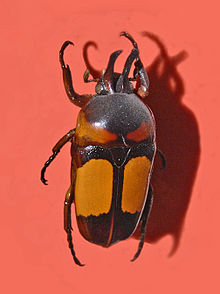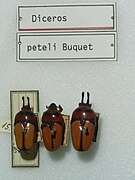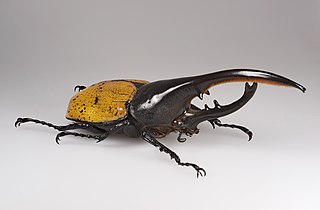
The Hercules beetle is a species of rhinoceros beetle native to the rainforests of Central America, South America, and the Lesser Antilles. It is the longest extant species of beetle in the world, and is also one of the largest flying insects in the world.

Flower chafers are a group of scarab beetles, comprising the subfamily Cetoniinae. Many species are diurnal and visit flowers for pollen and nectar, or to browse on the petals. Some species also feed on fruit. The group is also called fruit and flower chafers, flower beetles and flower scarabs. There are around 4,000 species, many of them still undescribed.

The Atlas beetle is a very large species of beetle in the family Scarabaeidae, found in Southeast Asia. Males have three prominent horns. The species is named for Atlas, the giant of Greek mythology who supported the skies.

Pachnoda sinuata, the garden fruit chafer or checkers tor or brown-and-yellow fruit chafer, is a species of beetle found in Namibia and South Africa.
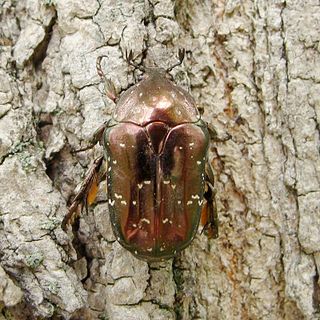
Protaetia is a genus of beetles of the family Scarabaeidae, occurring primarily in Asia, and containing over 300 species.
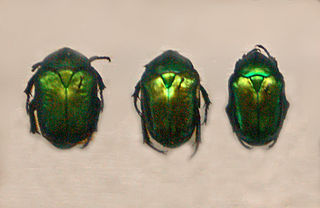
Protaetia speciosa is a beetle of the family Scarabaeidae and subfamily Cetoniinae.

Gnathocera is a genus of beetles belonging to the family Scarabaeidae.

Gnathocera varians is a species of beetles belonging to the family Scarabaeidae.
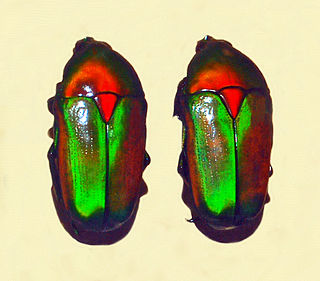
Chlorocala is a genus of beetles belonging to the family Scarabaeidae.

Euselates is a genus of beetle belonging to the family Scarabaeidae.

Gymnetis holosericea is a species of beetles of the family Scarabaeidae and subfamily Cetoniinae.

Aethiessa floralis is a species of beetles belonging to the family Scarabaeidae, subfamily Cetoniinae.

Trichostetha is a genus of beetle in the scarab beetle family. It is endemic to southern Africa, and its species most commonly occur in mountainous terrain. The genus includes several species that have only recently been described, as well as many species lacking a description of any of the larval stages. Except for T. fascicularis and its subspecies, the species comprising Trichostetha have small ranges of distribution, frequently in the Cape Floral Region of South Africa.

Hoplopyga is a genus of beetles of the family Scarabaeidae. These beetles can be found in Central and South America.
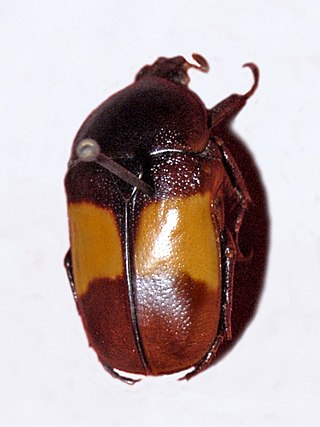
Chondrorrhina abbreviata is a species of fruit and flower chafers belonging to the family Scarabaeidae, subfamily Cetoniinae.

Chalcothea is a genus of flower chafers belonging to the family scarab beetles.
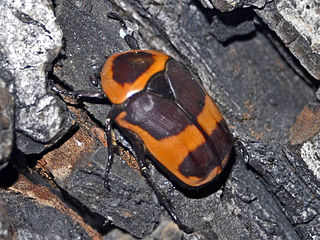
Pachnoda savignyi, the sun beetle, is a beetle belonging to the family Scarabaeidae.

Megasoma anubis is a species of beetles belonging to the family Scarabaeidae.

Trichiotinus is a genus of fruit and flower chafers in the family Scarabaeidae. There are about 8 described species in Trichiotinus, all native to the New World.
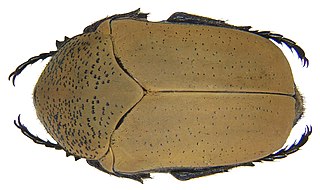
Hologymnetis is a genus of fruit and flower chafers in the family Scarabaeidae. There are about eight described species in the genus Hologymnetis.
